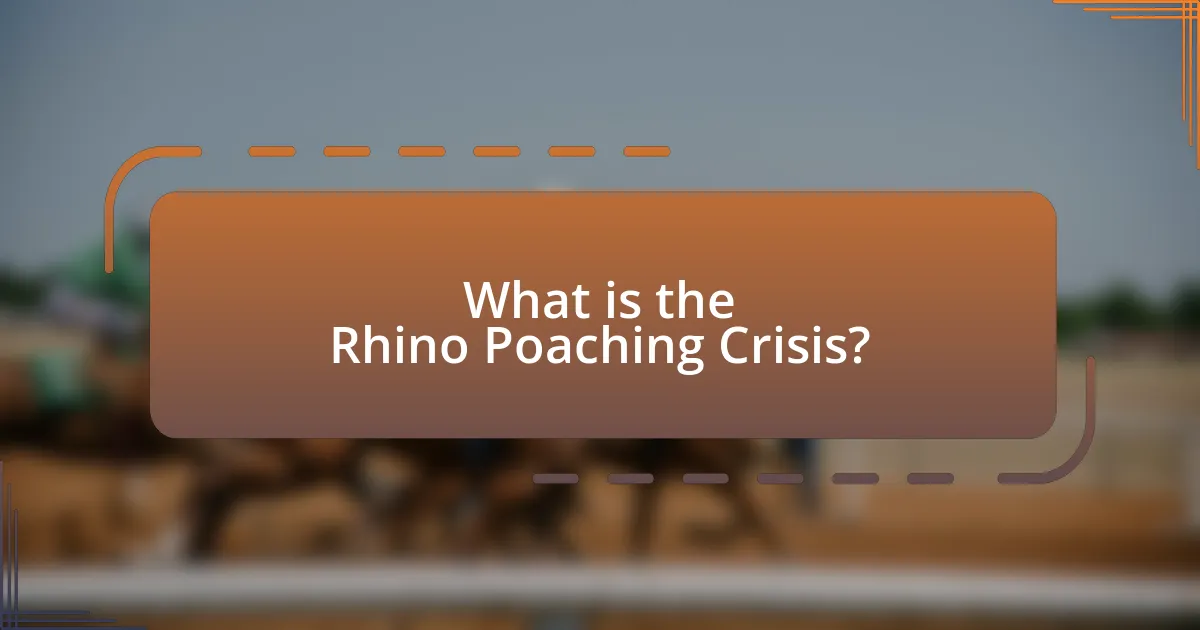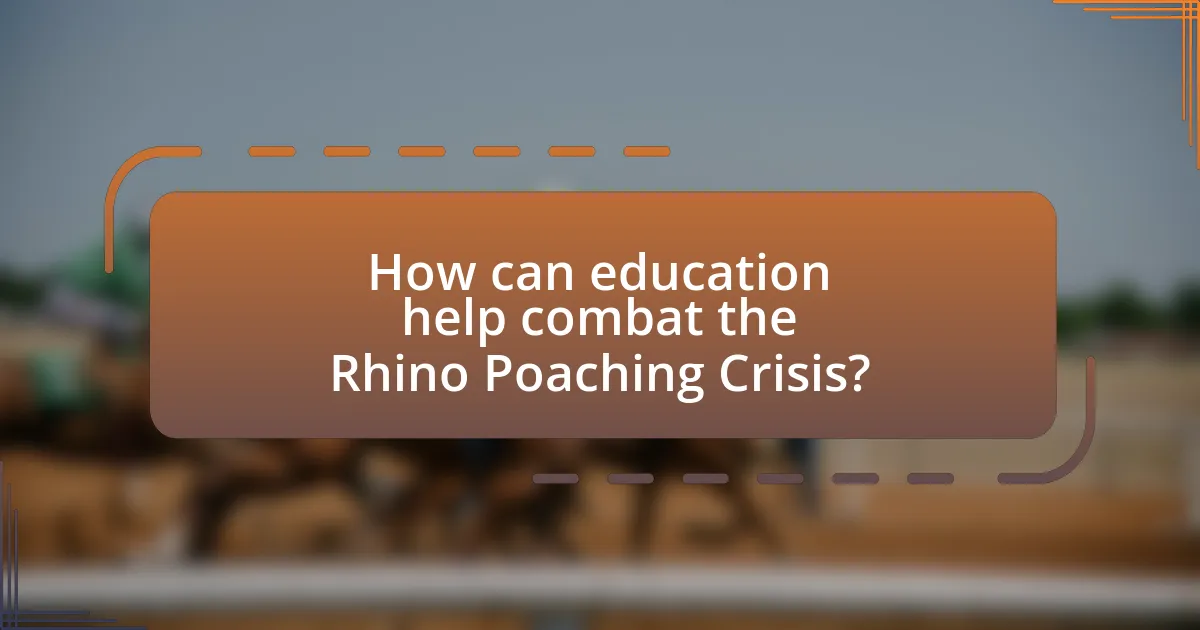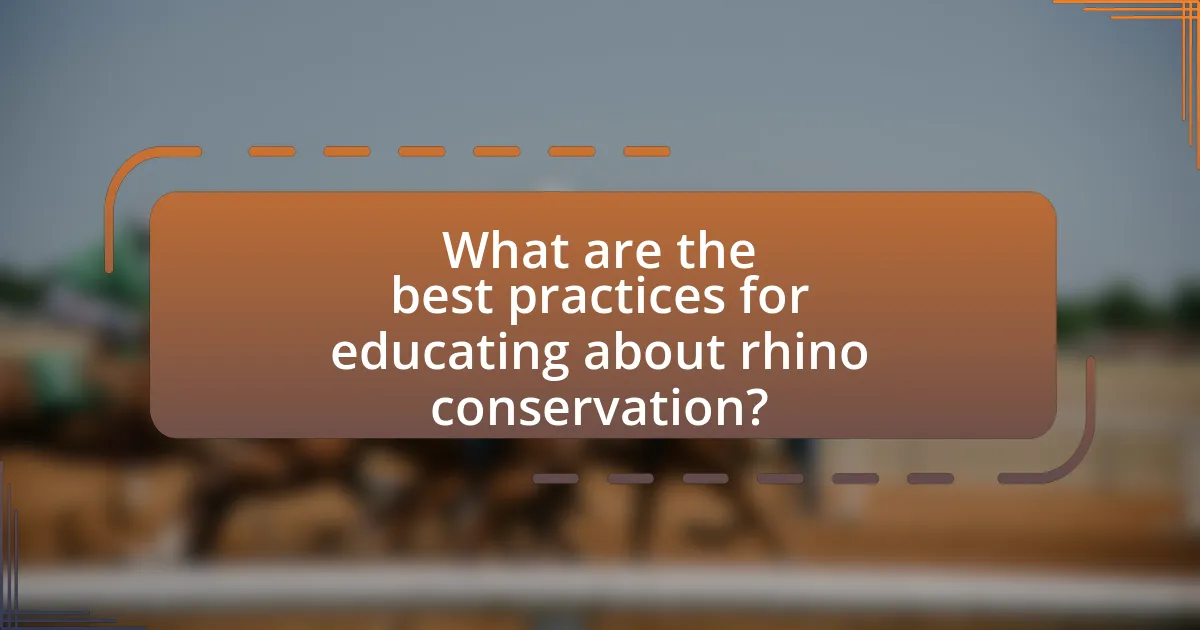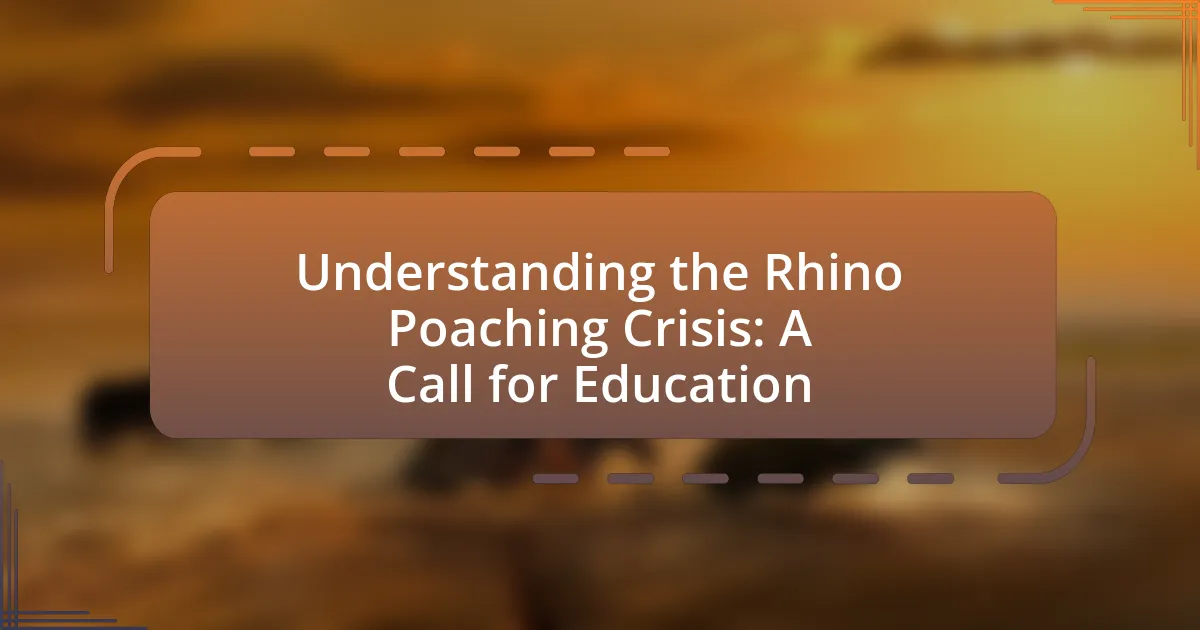The Rhino Poaching Crisis refers to the illegal hunting of rhinoceroses for their horns, primarily driven by demand in traditional medicine and as status symbols. This crisis has resulted in a significant decline in rhino populations, particularly in South Africa, where over 1,000 rhinos are poached annually. The article explores the causes and consequences of rhino poaching, its impact on ecosystems and local communities, and the economic implications of this illegal trade. It emphasizes the critical role of education and community involvement in combating poaching, highlighting effective strategies and partnerships that can enhance conservation efforts. The article ultimately calls for increased awareness and action to protect these endangered species.

What is the Rhino Poaching Crisis?
The Rhino Poaching Crisis refers to the illegal hunting of rhinoceroses for their horns, driven primarily by demand in traditional medicine and as status symbols. This crisis has led to a dramatic decline in rhino populations, with estimates indicating that over 1,000 rhinos were poached annually in recent years, particularly in South Africa, which is home to the majority of the world’s rhinos. The International Union for Conservation of Nature (IUCN) reports that the white rhino population has decreased by approximately 90% since the 1970s due to poaching and habitat loss.
Why is rhino poaching a significant issue today?
Rhino poaching is a significant issue today primarily due to the drastic decline in rhino populations, driven by illegal demand for their horns. In the last decade, poaching rates have surged, with over 1,000 rhinos killed annually in recent years, particularly in South Africa, which is home to the majority of the world’s rhino population. This illegal trade is fueled by the belief in the medicinal properties of rhino horn, despite scientific evidence disproving these claims. The loss of rhinos disrupts ecosystems, as they play a crucial role in maintaining the balance of their habitats. Additionally, the poaching crisis poses serious challenges to conservation efforts and biodiversity, threatening the survival of these iconic species.
What are the main causes of rhino poaching?
The main causes of rhino poaching are high demand for rhino horn in traditional medicine and status symbols, along with organized crime syndicates driving illegal trade. The escalating prices of rhino horn, which can reach up to $60,000 per kilogram, incentivize poachers to target these animals. Additionally, habitat loss and insufficient law enforcement contribute to the vulnerability of rhinos, making them easier targets for poachers. According to the World Wildlife Fund, rhino populations have declined significantly due to these factors, highlighting the urgent need for conservation efforts.
How does rhino poaching impact ecosystems?
Rhino poaching significantly disrupts ecosystems by removing a keystone species that plays a crucial role in maintaining the balance of their habitats. Rhinos contribute to the ecosystem by grazing on vegetation, which helps to shape the landscape and promote biodiversity. Their presence supports various plant species and creates habitats for other wildlife. The loss of rhinos can lead to overgrowth of certain plants, which may outcompete other species, ultimately reducing biodiversity and altering the structure of the ecosystem. Studies have shown that the decline of large herbivores like rhinos can lead to cascading effects throughout the food web, impacting both flora and fauna.
What are the statistics surrounding rhino poaching?
In 2021, approximately 27 rhinos were poached in South Africa, a significant decrease from the peak of 1,215 rhinos poached in 2014. This decline is attributed to increased anti-poaching efforts and stricter law enforcement. However, the overall trend since 2008 shows that over 9,000 rhinos have been killed for their horns, primarily driven by demand in Asian markets. The International Rhino Foundation reports that the white rhino population has decreased from about 20,000 in 2010 to around 18,000 in 2021, while the critically endangered Javan and Sumatran rhinos face even more severe threats, with fewer than 80 and 80 individuals remaining, respectively.
How have rhino populations changed over the years?
Rhino populations have significantly declined over the years, primarily due to poaching and habitat loss. In the early 20th century, there were approximately 500,000 rhinos globally, but by 1970, this number had dropped to around 70,000. As of 2021, the total population of rhinos is estimated to be about 27,000, with the majority being white rhinos and a critically low number of Javan and Sumatran rhinos remaining. The International Rhino Foundation reports that poaching rates surged in the 2000s, with over 1,000 rhinos killed annually at the peak of the crisis. Conservation efforts have led to some recovery in specific populations, but overall, rhinos remain endangered and face ongoing threats.
What regions are most affected by rhino poaching?
The regions most affected by rhino poaching are primarily Southern Africa, particularly South Africa, Namibia, Zimbabwe, and Kenya. These areas have experienced significant poaching incidents due to high demand for rhino horn in illegal markets, particularly in Asia. For instance, South Africa alone reported over 1,000 rhinos poached in 2013, highlighting the severity of the crisis in this region.
What are the consequences of rhino poaching?
Rhino poaching leads to severe ecological, economic, and social consequences. Ecologically, the decline in rhino populations disrupts ecosystems, as rhinos play a crucial role in maintaining the balance of their habitats. Economically, poaching undermines tourism, which is vital for many countries that rely on wildlife tourism; for instance, in South Africa, wildlife tourism contributes billions to the economy, and the loss of rhinos can deter tourists. Socially, poaching fuels organized crime and violence, creating instability in communities where poaching occurs. According to the World Wildlife Fund, rhino populations have decreased by over 90% in the last century due to poaching, highlighting the urgent need for conservation efforts.
How does rhino poaching affect local communities?
Rhino poaching negatively impacts local communities by undermining their economic stability and disrupting social structures. When rhinos are poached, local economies that rely on eco-tourism suffer, as the loss of these animals diminishes wildlife attractions. For instance, in South Africa, the decline in rhino populations has led to a decrease in tourism revenue, which is crucial for community development and job creation. Additionally, poaching can lead to increased violence and insecurity, as criminal networks exploit local populations, further destabilizing communities. This situation creates a cycle of poverty and conflict, making it difficult for local residents to thrive.
What are the economic implications of rhino poaching?
Rhino poaching has significant negative economic implications, primarily affecting tourism revenue and conservation funding. The decline in rhino populations due to poaching reduces wildlife tourism, which is a vital source of income for many countries, particularly in Africa. For instance, in South Africa, wildlife tourism contributes approximately $8.1 billion annually to the economy, and the presence of rhinos is a key attraction for tourists. Additionally, the loss of rhinos undermines conservation efforts, leading to increased costs for anti-poaching measures and habitat protection, which can strain local and national budgets. The economic impact extends to local communities that rely on sustainable wildlife tourism for their livelihoods, as poaching diminishes the natural resources they depend on.

How can education help combat the Rhino Poaching Crisis?
Education can help combat the Rhino Poaching Crisis by raising awareness about the ecological importance of rhinos and the consequences of poaching. Through educational programs, communities can learn about the role rhinos play in their ecosystems, which fosters a sense of stewardship and responsibility towards wildlife conservation. For instance, studies have shown that communities engaged in conservation education are more likely to support anti-poaching initiatives and report illegal activities. Furthermore, education can provide alternative livelihoods, reducing reliance on poaching as a source of income. Programs that teach sustainable practices and promote ecotourism have been effective in regions where poaching is prevalent, demonstrating that informed communities can significantly contribute to the protection of rhinos.
What role does education play in wildlife conservation?
Education plays a crucial role in wildlife conservation by fostering awareness and understanding of ecological issues, which can lead to more effective conservation efforts. Through educational programs, individuals learn about the importance of biodiversity, the threats faced by wildlife, and the impact of human activities on ecosystems. For instance, studies have shown that communities engaged in conservation education are more likely to participate in protective measures for endangered species, such as rhinos, which are heavily affected by poaching. Research published in the journal “Conservation Biology” indicates that educational initiatives can significantly reduce poaching rates by empowering local populations with knowledge and resources to protect their wildlife.
How can awareness campaigns reduce poaching rates?
Awareness campaigns can reduce poaching rates by educating communities about the ecological and economic importance of wildlife conservation. These campaigns inform local populations about the negative impacts of poaching on biodiversity and the potential benefits of sustainable practices, such as eco-tourism. For instance, a study by the World Wildlife Fund found that communities engaged in awareness programs showed a 30% decrease in poaching incidents over a three-year period. By fostering a sense of stewardship and providing alternative livelihoods, awareness campaigns can effectively shift attitudes and behaviors towards wildlife protection.
What educational programs are effective in anti-poaching efforts?
Educational programs that are effective in anti-poaching efforts include community-based conservation initiatives, wildlife education in schools, and awareness campaigns targeting local populations. Community-based conservation programs, such as the African Wildlife Foundation’s initiatives, empower local communities by involving them in wildlife management and providing economic incentives for conservation, which has been shown to reduce poaching rates. Wildlife education in schools, like the programs implemented by the World Wildlife Fund, teaches children about the importance of biodiversity and the consequences of poaching, fostering a conservation ethic from a young age. Additionally, awareness campaigns, such as the “I Am Wildlife” campaign, effectively engage local communities and tourists, raising awareness about the impacts of poaching and encouraging reporting of illegal activities. These educational approaches have been validated by various studies indicating a correlation between education and reduced poaching incidents.
Why is community involvement crucial in education efforts?
Community involvement is crucial in education efforts because it fosters collaboration between schools and local stakeholders, enhancing the relevance and effectiveness of educational programs. Engaging community members, such as parents, local organizations, and businesses, creates a support network that can provide resources, expertise, and real-world context to learning experiences. For instance, studies show that schools with strong community ties often see improved student performance and higher graduation rates, as community members contribute to a more enriching educational environment. This collaboration is particularly vital in addressing specific issues like the rhino poaching crisis, where local knowledge and commitment can drive awareness and conservation education initiatives.
How can local communities be empowered through education?
Local communities can be empowered through education by providing them with knowledge and skills that enhance their understanding of conservation and sustainable practices. Education fosters awareness about the ecological importance of rhinos and the impact of poaching, enabling community members to engage in protective measures. For instance, programs that teach local populations about the economic benefits of ecotourism can shift perspectives, encouraging them to protect wildlife rather than exploit it. Research indicates that communities involved in conservation education are more likely to participate in anti-poaching initiatives, as seen in various successful programs across Africa, where educated locals have become advocates for wildlife protection.
What partnerships can enhance educational initiatives?
Partnerships between educational institutions, conservation organizations, and local communities can significantly enhance educational initiatives related to the rhino poaching crisis. These collaborations facilitate the sharing of resources, expertise, and local knowledge, which are essential for developing effective educational programs. For instance, partnerships with wildlife conservation NGOs can provide access to up-to-date research and field data, while local communities can offer insights into cultural attitudes towards wildlife and poaching. A study by the World Wildlife Fund highlights that community-based education programs, when supported by NGOs and schools, have led to increased awareness and reduced poaching rates in several regions. This evidence underscores the importance of collaborative efforts in fostering a comprehensive understanding of the rhino poaching crisis through education.

What are the best practices for educating about rhino conservation?
The best practices for educating about rhino conservation include engaging local communities, utilizing multimedia resources, and implementing hands-on conservation programs. Engaging local communities fosters a sense of ownership and responsibility towards rhino conservation, as evidenced by successful initiatives in South Africa where community involvement has led to increased protection of rhinos. Utilizing multimedia resources, such as documentaries and social media campaigns, effectively raises awareness and reaches a broader audience, as shown by the viral impact of campaigns like “Save the Rhino.” Implementing hands-on conservation programs, such as wildlife monitoring and anti-poaching training, provides practical experience and empowers individuals to contribute actively to conservation efforts, which has been demonstrated to reduce poaching rates in various regions.
How can technology be utilized in educational programs?
Technology can be utilized in educational programs by integrating digital tools and platforms that enhance learning experiences and accessibility. For instance, online learning management systems enable educators to deliver content, track student progress, and facilitate communication. Additionally, virtual reality simulations can immerse students in real-world scenarios, such as wildlife conservation efforts, providing a deeper understanding of issues like rhino poaching. Research indicates that technology in education can improve engagement and retention rates; a study by the U.S. Department of Education found that students in technology-rich environments performed better than those in traditional settings.
What digital tools are effective for raising awareness?
Social media platforms, email campaigns, and websites are effective digital tools for raising awareness. Social media platforms like Facebook, Twitter, and Instagram enable organizations to reach a broad audience quickly, facilitating the sharing of impactful visuals and stories related to the rhino poaching crisis. Email campaigns allow for targeted messaging, reaching individuals who have already expressed interest in conservation efforts, thus increasing engagement. Websites serve as comprehensive resources, providing detailed information, statistics, and calls to action, which can educate the public and mobilize support. According to a 2020 study by the Pew Research Center, 69% of adults in the U.S. use social media, highlighting its potential reach for awareness campaigns.
How can social media campaigns influence public perception?
Social media campaigns can significantly influence public perception by shaping narratives and disseminating information rapidly. These campaigns utilize targeted messaging and visual content to engage audiences, often leading to increased awareness and emotional responses regarding issues like rhino poaching. For instance, a study by the Pew Research Center found that 69% of adults in the U.S. use social media, making it a powerful tool for advocacy and education. By leveraging hashtags, viral content, and influencer partnerships, social media campaigns can mobilize public opinion and drive action, as evidenced by successful initiatives that have raised funds and awareness for wildlife conservation efforts.
What strategies can be implemented for effective outreach?
Effective outreach strategies for addressing the rhino poaching crisis include community engagement, educational programs, and partnerships with local organizations. Community engagement fosters local support and awareness, which is crucial for conservation efforts. Educational programs can inform the public about the ecological importance of rhinos and the consequences of poaching, thereby changing perceptions and behaviors. Collaborating with local organizations enhances resource sharing and amplifies outreach efforts, as these groups often have established trust within their communities. Research indicates that community-based conservation initiatives can significantly reduce poaching rates, demonstrating the effectiveness of these strategies in real-world applications.
How can schools incorporate wildlife education into their curriculum?
Schools can incorporate wildlife education into their curriculum by integrating lessons on biodiversity, ecosystems, and conservation into existing subjects such as science, geography, and social studies. This approach allows students to understand the importance of wildlife and the impact of human activities on species like rhinos, which are critically endangered due to poaching. For instance, a study by the World Wildlife Fund highlights that educational programs focused on wildlife conservation can increase awareness and foster a sense of responsibility among students, leading to proactive behaviors in protecting endangered species. Additionally, hands-on activities such as field trips to wildlife reserves or partnerships with local conservation organizations can enhance learning experiences and provide real-world context to the issues surrounding wildlife conservation.
What community events can promote rhino conservation awareness?
Community events that can promote rhino conservation awareness include educational workshops, wildlife film screenings, and community clean-up days focused on local habitats. Educational workshops can provide information on rhino poaching and conservation efforts, engaging participants through interactive discussions and expert speakers. Wildlife film screenings can showcase documentaries that highlight the plight of rhinos, fostering empathy and understanding among viewers. Community clean-up days can emphasize the importance of preserving natural habitats, encouraging local involvement in conservation efforts. These events not only raise awareness but also foster community engagement, which is crucial for effective conservation initiatives.
What practical steps can individuals take to support rhino conservation?
Individuals can support rhino conservation by actively participating in awareness campaigns and donating to reputable wildlife organizations focused on rhino protection. Engaging in educational initiatives helps spread knowledge about the threats rhinos face, such as poaching and habitat loss. For instance, organizations like Save the Rhino International provide resources and programs that individuals can support financially or through volunteer work. Additionally, advocating for stronger anti-poaching laws and policies can influence government action, as evidenced by the success of community-led conservation efforts in countries like South Africa, where local involvement has led to a significant decrease in rhino poaching incidents.
